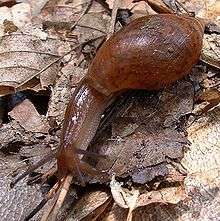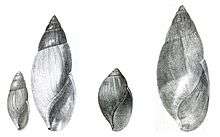Euglandina
| Euglandina | |
|---|---|
 | |
| A live individual of Euglandina rosea | |
| Scientific classification | |
| Kingdom: | Animalia |
| Phylum: | Mollusca |
| Class: | Gastropoda |
| (unranked): | clade Heterobranchia clade Euthyneura |
| Superfamily: | Testacelloidea |
| Family: | Spiraxidae |
| Subfamily: | Euglandininae |
| Genus: | Euglandina Crosse & P. Fischer, 1870[1] |
| Diversity[2] | |
| At least 44 species | |
Euglandina is a genus of predatory medium- to large-sized air-breathing land snails, terrestrial pulmonate gastropod mollusks in the family Spiraxidae.[3]
These snails were previously placed in the family Oleacinidae (according to the taxonomy of the Gastropoda by Bouchet & Rocroi, 2005).
Euglandina is the type genus of the subfamily Euglandininae. The pulmonate genus Euglandina is often referred to as Glandina in older literature, and the most widely known species, Euglandina rosea, may commonly be found under the synonym Glandina truncata.[4]
These snails are especially notable for being carnivorous and predatory. They are sometimes called "wolf snails" for that reason.
Distribution
The natural range of Euglandina encompasses much of the tropical and subtropical Western Hemisphere, including the SE United States to Texas, Mexico, and various locations in Central and South America. The species Euglandina rosea has been intentionally introduced into many other warm areas — from Hawaii to New Guinea, Bermuda, Sri Lanka, Mauritius, and numerous other locations — in a vain attempt to control accidentally introduced species of snails, usually the giant African Achatina fulica.[5]
Those species of Euglandina that are non-indigenous to the USA have not yet become established in the USA, but they are considered to represent a potentially serious threat as a pest, an invasive species which could negatively affect agriculture, natural ecosystems, human health or commerce. Therefore it has been suggested that these species be given top national quarantine significance in the USA.[6]

Species

There are three subgenera[2] and species in the genus Euglandina include:
Subgenus Euglandina Crosse & Fischer, 1870
- Euglandina aurata (Morelet, 1849)[9] - type species[2]
- Euglandina bailyi M. Smith, 1950[2]
- Euglandina binneyana (Pfeiffer, 1845)[2]
- Euglandina cognata (Strebel, 1875)[2]
- Euglandina cuneus (Von Martens, 1891)[2]
- Euglandina dactylus (Broderip, 1832)[2]
- Euglandina daudebarti (Deshayes, 1850)[2]
- Euglandina gigantea Pilsbry, 1926[2][9]
- Euglandina huingensis (Pilsbry, 1903)[2]
- Euglandina immemorata Pilsbry, 1907[2]
- Euglandina indusiata (Pfeiffer, 1860)[2]
- Euglandina lamyi (Fischer & Chatelet, 1903)[2]
- Euglandina liebmanni (Pfeiffer, 1846)[2]
- Euglandina livida Dall, 1908[2]
- Euglandina michoacanensis (Pilsbry, 1899)[2]
- Euglandina pan Thompson, 1987[2][9]
- Euglandina pilsbryi Bartsch, 1909[2]
- Euglandina pinicola (Fischer & Crosse, 1870)[2]
- Euglandina radula (Strebel, 1875)[2]
- Euglandina sowerbyana (Pfeiffer, 1846)[2][9]
- Euglandina striata (Müller, 1774)[2]
- Euglandina texasiana (Pfeiffer, 1856)[2]
- Euglandina texasiana angustior Pilsbry & Vanatta, 1936[2]
- Euglandina titan Thompson, 1987[2][9]
- Euglandina vanuxemensis (Lea, 1834)[2][9]
Subgenus Singleya H. B. Baker, 1941[2]
- Euglandina anomala (Angas, 1879)[2]
- Euglandina anomala barrocoloradensis Pilsbry, 1930[2]
- Euglandina balesi Pilsbry, 1938[2]
- Euglandina candida (Shuttleworth, 1852)[2]
- Euglandina candida conularis (Pfeiffer, 1855)[2]
- Euglandina carminensis (Morelet, 1849)[2]
- Euglandina corneola (W. G. Binney, 1857)[2]
- Euglandina decussata (Deshayes, 1840)[2]
- Euglandina excavata (Von Martens, 1891)[2]
- Euglandina ghiesbreghti (Pfeiffer, 1856)[2]
- Euglandina hererrae (Contreras, 1923)[2]
- Euglandina insignis (Pfeiffer, 1855)[2]
- Euglandina jacksoni Pilsbry & Vanatta, 1936[2]
- Euglandina longula (Fischer & Crosse, 1870)[2]
- Euglandina lowei Pilsbry, 1931[2]
- Euglandina mazatlanica (Von Martens, 1891)[2]
- Euglandina mazatlanica abbreviata (Von Martens, 1891)[2]
- Euglandina pseudoturris (Strebel, 1875)[2]
- Euglandina singleyana (W. G. Binney, 1878)[2]
- Euglandina tenella (Strebel, 1875)[2]
- Euglandina turris (Pfeiffer, 1846)[2]
- Euglandina turris longurio Pilsbry & Cockerell, 1926[2]
- Euglandina wani (Jacobson, 1968)[2]
Subgenus Cosmomenus H. B. Baker, 1941[2]
- Euglandina cumingi (Beck, 1827)[2]
- Euglandina cylindracea (Phillips, 1846)[2]
Subgenus ?
- Euglandina exesa - fossil
- Euglandina rosea (Férussac, 1821)
- Euglandina rosea bullata
Description
The various species of Euglandina are similar in numerous ways. The shells are simple, oval in outline (sometimes broadly so) but occasionally more-or-less straight-sided, The lip of the aperture is also simple, without any thickening. These shells may be brown, orange, or pink in color, or some intermediate shade. Shell sculpture when present usually consists of striae that mark progressive growth increments. All species are carnivores, and probably have essentially the same hunting and feeding strategies,[10][11] and reproductive techniques.[12]
Habitat
Members of this genus can be found in many micro-habitats. Species of Euglandia can be found in semi-tropical moist jungle, and in near-desert. Their only requirements seem to be a relatively warm climate, and the presence of a sufficient supply of food organisms.
References
- ↑ Crosse & Fischer P. (1870). Miss. Sci. Méxique et Amér. Centr., Rech. zool. 7(1): 97.
- 1 2 3 4 5 6 7 8 9 10 11 12 13 14 15 16 17 18 19 20 21 22 23 24 25 26 27 28 29 30 31 32 33 34 35 36 37 38 39 40 41 42 43 44 45 46 47 48 49 50 51 52 53 54 55 56 57 58 Thompson F. G. (16 June 2008). "AN ANNOTATED CHECKLIST AND BIBLIOGRAPHY OF THE LAND AND FRESHWATER SNAILS OF MEXICO AND CENTRAL AMERICA". "PART 4 PULMONATA (ACHATINOIDEA-SAGDOIDEA)". accessed 14 January 2011.
- ↑ Thompson, F. G. (2010). "Four species of land snails from Costa Rica and Panama (Pulmonata: Spiraxidae)". Revista de biologia tropical. 58 (1): 195–202. PMID 20411717., PDF.
- ↑ Pilsbry H. A. (1946). Land Mollusca of North America (North of Mexico). Vol. 2, Pt. 1. Acad. Nat. Sci. Philadelphia Monograph 3.
- ↑ Columbia Univ. Introduced Species Project. Rosy Wolfsnail (Euglandina rosea). http://www.columbia.edu/itc/cerc/danoff-burg/invasion_bio/inv_spp_summ/Euglandina_rosea.html
- ↑ Cowie R. H., Dillon R. T., Robinson D. G. & Smith J. W. (2009). "Alien non-marine snails and slugs of priority quarantine importance in the United States: A preliminary risk assessment". American Malacological Bulletin 27: 113-132. PDF.
- ↑ Binney W. G. (1878). "The Terrestrial Air-Breathing Mollusks of the United States and Adjacent Territories of North America". Vol. 5 (plates). Bull. Mus. Comparative Zool., Harvard. Plate 59.
- ↑ Binney W. G. (1878). Plates 60, 61, 62. and 62a.
- 1 2 3 4 5 6 7 Thompson F. D. (1987). "Giant carnivorous land snails from Mexico and Central America". Bulletin of the Florida State Museum (Biological Sciences) 30(2): 29-52.
- ↑ Cook A. (1983). "Feeding by the carnivorous snail Euglandina rosea Férrusac". Journal of Molluscan Studies 49: 32-35.
- ↑ Harry H. W. (1983). "Notes on the flesh-eating land snail, Euglandina rosea in Texas, and its feeding habits". Texas Conchologist 20(1): 23-27.
- ↑ Cook A. (1985). "The courtship of Euglandina rosea Férrusac". Journal of Molluscan Studies 51: 211-214.
Further reading
| Wikimedia Commons has media related to Euglandina. |
- Hubricht L. (1985). "The distribution of the native land mollusks of the eastern United States". Fieldiana Zoology 24: 1-191.
- Perez K. & Strenth N. E. (2003). "A systematic review of the land snail Euglandina singleyana (Binney, 1892) (Mollusca: Gastropoda: Spiraxidae)". Proc. Biol. Soc. Washington 116(3): 649-660.
- Perez K. & Strenth N. E. (2002). "Enzymatic variation in the land snail Euglandina texasiana (Gastropoda: Pulmonata) from south Texas and northeastern Mexico". Texas J. Science, 1 February 2002.